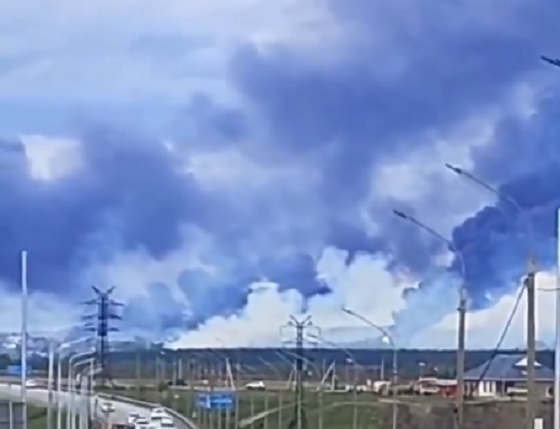conflict
“Will Be in History Books”: Zelensky Hails Long-Range Drone Strike That Hit Dozens of Russian Bombers

 Sam Cooper
Sam Cooper
“Borderline Insane”: Analyst Warns American Military Must Prepare as Ukraine’s Deep Strike Signals China Could Launch Similar Attacks from U.S. Ports in Event of War Over Taiwan

KYIV — In its most daring covert action of the war, Ukraine says it has destroyed or severely damaged more than 40 Russian long-range strategic aircraft in a meticulously planned drone assault that struck four military airbases deep inside Russian territory. The campaign, known as Operation Spider’s Web, marks a stunning escalation in Ukraine’s asymmetric warfare strategy—and what some analysts are calling a historic reversal that could tilt the odds in peace negotiations against the larger aggressor.
The mission—overseen by Ukraine’s Security Service (SBU) and personally authorized by President Volodymyr Zelensky—reportedly took more than 18 months to prepare. SBU operatives smuggled first-person-view drones into Russia hidden inside wooden mobile cabins mounted on civilian cargo trucks. When activated remotely, the trucks’ roofs opened and the drones launched directly at parked Russian bombers.
“This was our most long-range operation,” Zelensky posted Sunday on X, noting the assault involved only Ukrainian forces. “One year, six months, and nine days from the start of planning to execution. These are Ukrainian actions that will undoubtedly be in history books.”
The strikes hit four airbases far from the front lines: Belaya airbase in Irkutsk Oblast, Olenya in Murmansk near the Arctic Circle, Dyagilevo in Ryazan Oblast, and Ivanovo in central Russia.
According to Ukrainian intelligence sources cited by the BBC, the damaged assets include Tu-95 and Tu-22M3 nuclear-capable strategic bombers, as well as an A-50 airborne early warning and control aircraft. The total estimated damage exceeds $2 billion USD.
Footage posted on Russian and Ukrainian Telegram channels showed plumes of smoke rising from the affected airbases. In one widely circulated clip, a bystander can be heard saying drones had launched from “a Kamaz truck near a petrol station.” Russian state media acknowledged strikes across five regions and labeled the attacks “a terrorist act.” However, prominent Russian military bloggers confirmed the loss of aircraft and critical infrastructure, including fuel storage depots.
Irkutsk Governor Igor Kobzev confirmed the Belaya strike, stating the drones had been launched from a civilian truck and that the situation was “under control” with no casualties reported.
SBU officials told the BBC that Spider’s Web was a “logistical and operational breakthrough,” describing a multi-stage smuggling effort that first inserted the FPV drones into Russia, followed later by mobile launch platforms. “Once on Russian territory, the drones were hidden under the roofs of these cabins,” one source said. “At the right moment, the roofs were remotely opened, and the drones took off.”
Zelensky credited SBU chief General Vasyl Maliuk with executing the unprecedented strike. “I thanked General Maliuk for this success of Ukraine,” Zelensky said. “We are doing everything to make Russia feel the need to end this war. Russia started this war. Russia must end it.”
The operation comes amid intensifying cross-border attacks by both sides. Hours earlier, a Russian missile barrage killed 12 Ukrainian soldiers and injured over 60 at a training base. Ukrainian air defenses responded by reportedly downing 385 Russian aerial targets across multiple regions.
The timing of the drone assault—just ahead of a second round of peace talks in Istanbul on Monday—appears aimed at pressuring Moscow. Zelensky has demanded a “complete and unconditional ceasefire,” while Russian officials are calling for a halt to Western arms transfers to Ukraine, a condition Kyiv rejects.
“These strikes are a clear and effective guarantee of Ukraine’s security,” Zelensky said. “Glory to Ukraine.”
Military analyst Tom Shugart noted the implications of the strike could extend far beyond the European theater, warning that Ukraine’s use of covert drone launches deep inside enemy territory raises implications for China’s global trade and access to Western ports.
“A reminder, given today’s Ukrainian drone strikes, that it is becoming borderline-insane that we routinely allow ships owned and operated by DoD-designated Chinese military companies to sit in our ports with thousands of containers onboard and under their control,” Shugart posted Sunday afternoon, referencing mounting U.S. tensions with China over its aggression toward Taiwan.
The Bureau is a reader-supported publication.
To receive new posts and support my work, consider becoming a free or paid subscriber.
Invite your friends and earn rewards
conflict
One dead, over 60 injured after Iranian missiles pierce Iron Dome

 MxM News
MxM News
Quick Hit:
Iran launched four waves of missile attacks Friday night, breaching Israel’s defenses and killing at least one person. Over 60 others were injured, with the IDF confirming direct strikes on civilian areas in Tel Aviv and central Israel.
Key Details:
-
The Israel Defense Forces reported four rounds of Iranian missile fire, with at least ten missiles making impact inside Israel.
-
One person was killed and 63 wounded, including several in critical condition, according to The Jerusalem Post.
-
The IDF said Iran deliberately targeted civilians, contrasting its own earlier strikes that focused on Iranian military assets.
⚠️RAW FOOTAGE: Iran launched multiple ballistic missiles toward Israel in the past hours.
The IDF cannot, and will not, allow Iran to attack our civilians. pic.twitter.com/IrDK05uErm
— Israel Defense Forces (@IDF) June 13, 2025
Diving Deeper:
Several Iranian missiles broke through Israel’s air defenses during Friday night’s attack, striking Tel Aviv and other civilian areas. According to The Jerusalem Post, at least 63 people were wounded and one person was killed after four waves of Iranian ballistic missile strikes hit cities across Israel.
The IDF reportedly said roughly 100 missiles were fired in total. While the Iron Dome intercepted many, multiple missiles made it through and exploded in densely populated areas. Dramatic video showed a missile striking near downtown Tel Aviv, sending fire and debris into the air as people ran for cover.
Army Radio confirmed that ten missiles landed inside Israel between the first two waves. By the time the third and fourth waves hit, injuries had climbed sharply, with several listed in critical condition. The one fatality was reported late Friday night.
The Israeli Home Front Command temporarily allowed civilians to exit shelters but quickly reversed that guidance, urging residents to stay near protected areas amid fears of further attacks.
The IDF emphasized the nature of the targets, calling out Iran for targeting civilians. The IDF also released maps showing where air raid sirens were triggered throughout the night. Though Israel’s Home Front Command briefly allowed civilians to exit shelters, it advised them to remain nearby in case of continued strikes. As of late Friday, Iranian officials claimed a fifth wave could follow.
With tensions still high, Israeli defense officials are preparing for potential further escalation—and weighing how to respond to a direct Iranian attack on civilians.
conflict
Iran nuclear talks were ‘coordinated deception’ between US and Israel: report

From LifeSiteNews
Reports state that U.S. peace talks were a ruse and that Trump gave Netanyahu a ‘green light’ to hit Iran’s nuclear and military sites, killing top commanders.
A senior Israeli official told the Jerusalem Post that Tel Aviv and Washington worked together to convince Tehran that diplomacy was still possible after Israel was ready to attack Iran. Just hours before Israel’s massive assault began, President Donald Trump maintained he was still committed to talks.
The Israeli outlet reports, “The round of U.S.-Iranian nuclear negotiations scheduled for Sunday was part of a coordinated U.S.-Israeli deception aimed at lowering Iran’s guard ahead of Friday’s attack.”
READ: Israel strikes Iran’s nuclear sites, kills top commanders in massive air assault
In a post on Truth Social shortly before the Israeli strikes began, Trump declared that “We remain committed to a Diplomatic Resolution to the Iran Nuclear Issue! My entire Administration has been directed to negotiate with Iran. They could be a Great Country, but they first must completely give up hopes of obtaining a Nuclear Weapon. Thank you for your attention to this matter!”
After the Israeli attack was in progress, Secretary of State Marco Rubio denied that the U.S. was involved. However, American officials have said the White House was aware Israel was set to begin striking Iran, with Trump telling Fox News he was briefed on the operation.
Barak Ravid of Axios, moreover, later reported that Tel Aviv was given “a clear U.S. green light” to start bombing, citing two unnamed Israeli officials.
Sources speaking with Axios said the perceived split between Trump and Israeli Prime Minister Benjamin Netanyahu was coordinated behind the scenes. “Two Israeli officials claimed to Axios that Trump and his aides were only pretending to oppose an Israeli attack in public – and didn’t express opposition in private,” the report explained. “The goal, they say, was to convince Iran that no attack was imminent and make sure Iranians on Israel’s target list wouldn’t move to new locations.”
The sources said that Trump and Netanyahu discussed the attack during a phone call on Monday. After the call, reports said Trump pressed Netanyahu not to attack Iran, but that was another effort to deceive Iran.
In a second post following the attack, Trump said he gave Iran the opportunity to make a deal, and suggested that Israel used American weapons in the massive air raid. “I gave Iran chance after chance to make a deal. I told them, in the strongest of words, to ‘just do it,’ but no matter how hard they tried, no matter how close they got, they just couldn’t get it done,” the president wrote.
The post continued, “I told them it would be much worse than anything they know, anticipated, or were told, that the United States makes the best and most lethal military equipment anywhere in the World, BY FAR, and that Israel has a lot of it, with much more to come – And they know how to use it.”
The U.S. and Iran began negotiations on establishing a new nuclear agreement in April, with the two sides engaging in five rounds of Omani-mediated talks. At times, a deal appeared possible, with Iranian officials saying the dialogue was leading to progress. A sixth round of talks was scheduled for Sunday, but now appears unlikely.
A second source speaking with the Jerusalem Post said the goal of Israel’s military operations was not the complete destruction of Iran’s nuclear facilities, but rather to hit missile sites and top Iranian leaders to bring down the government.
Israel has conducted several rounds of strikes so far, hitting nuclear facilities, residential buildings in Tehran, and military sites. Iran has confirmed that several military leaders and nuclear scientists were killed in the bombing.
-

 National2 days ago
National2 days agoCarney promotes MP instrumental in freezing Freedom Convoy donors’ bank accounts
-

 Business2 days ago
Business2 days ago84% of Swiss hospitals and 60% of hospitalizations are in private facilities, and they face much lower wait times
-

 conflict21 hours ago
conflict21 hours agoIran nuclear talks were ‘coordinated deception’ between US and Israel: report
-

 Business2 days ago
Business2 days agoThe carbon tax’s last stand – and what comes after
-

 Health2 days ago
Health2 days agoRFK Jr. appoints Robert Malone, Martin Kulldorff, other COVID shot critics to overhauled CDC vaccine panel
-

 conflict1 day ago
conflict1 day agoIsrael strikes Iran, targeting nuclear sites; U.S. not involved in attack
-

 illegal immigration1 day ago
illegal immigration1 day agoLA protests continue as judge pulls back CA National Guard ahead of ‘No Kings Day’
-

 Alberta23 hours ago
Alberta23 hours agoPunishing Alberta Oil Production: The Divisive Effect of Policies For Carney’s “Decarbonized Oil”




